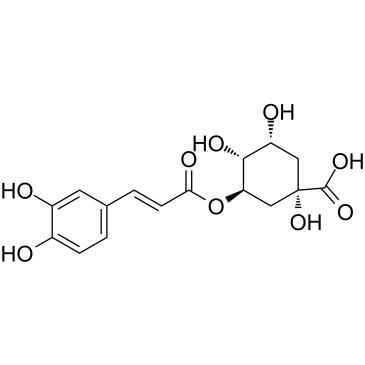
| 规格 | 价格 | 库存 | 数量 |
|---|---|---|---|
| 1g |
|
||
| 5g |
|
||
| 10g |
|
||
| 25g | |||
| 50g | |||
| Other Sizes |

| 体外研究 (In Vitro) |
在 CoCl2 诱导的缺氧 A549 细胞中,10 μM 绿原酸持续 16 小时可降低 HIF-1α 蛋白水平,但 HIF-1α mRNA 水平不受影响 [1]。绿原酸(10 μM,24 小时)可抑制缺氧。 Huh7 细胞增殖受到绿原酸(25、50 μM,24 小时)的抑制,这也会减少细胞迁移和数量 [4]。诱导HUVEC细胞迁移、胸腔和血管内皮细胞管形成[1]。
|
|---|---|
| 体内研究 (In Vivo) |
kg,侧壁)对实验性反流性食管炎具有保护作用[3]。绿原酸(10 mg/kg,静脉注射)可防止 LPS 中毒的 C57BL/6 喷嘴中的内毒素死亡和诱导的 TNF-α 释放,并改善 LPS/GalN 攻击小鼠的急性肝损伤 [2]。腹腔注射绿原酸(25-200 mg/kg)可以抑制具有Huh7或H446细胞的NOD/SCID小鼠的肿瘤生长[4]。
|
| 动物实验 |
Animal/Disease Models: Rat experimental reflux esophagitis (RE) [1]
Doses: 10, 30, 100 mg/kg Route of Administration: Oral Experimental Results:Reduce esophageal lipid peroxidation (marker: MDA) and increase reflux esophagitis Prototype glutathione/oxidized glutathione ratio. Inhibits the increase in serum TNF-α levels and the expression of iNOS and COX-2 proteins. Animal/Disease Models: LPS/GalN-challenged mice [2] Doses: 10 mg/kg Route of Administration: intravenous (iv) (iv)injection Experimental Results: The survival rate of LPS/GalN-intoxicated mice increased. Inhibits LPS/GalN-induced NF-κB p65 or c-Jun phosphorylation without affecting p-IRF3 levels in liver lobules. |
| 参考文献 |
|
| 其他信息 |
Chlorogenic acid is a cinnamate ester obtained by formal condensation of the carboxy group of trans-caffeic acid with the 3-hydroxy group of quinic acid. It is an intermediate metabolite in the biosynthesis of lignin. It has a role as a plant metabolite and a food component. It is a cinnamate ester and a tannin. It is functionally related to a (-)-quinic acid and a trans-caffeic acid. It is a conjugate acid of a chlorogenate.
Chlorogenic Acid has been used in trials studying the treatment of Advanced Cancer and Impaired Glucose Tolerance. Chlorogenic Acid has been reported in Camellia sinensis, Meum athamanticum, and other organisms with data available. Chlorogenic Acid is a polyphenol and the ester of caffeic acid and quinic acid that is found in coffee and black tea, with potential antioxidant and chemopreventive activities. Chlorogenic acid scavenges free radicals, which inhibits DNA damage and may protect against the induction of carcinogenesis. In addition, this agent may upregulate the expression of genes involved in the activation of the immune system and enhances activation and proliferation of cytotoxic T-lymphocytes, macrophages, and natural killer cells. Chlorogenic acid also inhibits the activity of matrix metalloproteinases. A naturally occurring phenolic acid which is a carcinogenic inhibitor. It has also been shown to prevent paraquat-induced oxidative stress in rats. (From J Chromatogr A 1996;741(2):223-31; Biosci Biotechnol Biochem 1996;60(5):765-68). See also: Arctium lappa Root (part of); Cynara scolymus leaf (part of); Lonicera japonica flower (part of) ... View More ... |
| 分子式 |
C16H18O9
|
|---|---|
| 分子量 |
354.309
|
| 精确质量 |
354.095
|
| CAS号 |
327-97-9
|
| 相关CAS号 |
Neochlorogenic acid;906-33-2;Chlorogenic acid-13C3
|
| PubChem CID |
1794427
|
| 外观&性状 |
White to off-white solid powder
|
| 密度 |
1.7±0.1 g/cm3
|
| 沸点 |
665.0±55.0 °C at 760 mmHg
|
| 熔点 |
210 °C (dec.)(lit.)
|
| 闪点 |
245.5±25.0 °C
|
| 蒸汽压 |
0.0±2.1 mmHg at 25°C
|
| 折射率 |
1.690
|
| LogP |
-0.36
|
| tPSA |
164.75
|
| 氢键供体(HBD)数目 |
6
|
| 氢键受体(HBA)数目 |
9
|
| 可旋转键数目(RBC) |
5
|
| 重原子数目 |
25
|
| 分子复杂度/Complexity |
534
|
| 定义原子立体中心数目 |
4
|
| SMILES |
C1[C@H]([C@H]([C@@H](C[C@@]1(C(=O)O)O)OC(=O)/C=C/C2=CC(=C(C=C2)O)O)O)O
|
| InChi Key |
CWVRJTMFETXNAD-XYXZIBEBSA-N
|
| InChi Code |
InChI=1S/C16H18O9/c17-9-3-1-8(5-10(9)18)2-4-13(20)25-12-7-16(24,15(22)23)6-11(19)14(12)21/h1-5,11-12,14,17-19,21,24H,6-7H2,(H,22,23)/b4-2-/t11-,12-,14-,16+/m1/s1
|
| 化学名 |
(1S,3R,4R,5R)-3-{[(2Z)-3-(3,4-dihydroxyphenyl)prop-2-enoyl]oxy}-1,4,5-trihydroxycyclohexanecarboxylic acid
|
| 别名 |
3-O-Caffeoylquinic acid; Heriguard; NSC-407296; NSC407296; NSC 407296; 3(34Dihydroxycinnamoyl)quinate; 3(34Dihydroxycinnamoyl)quinic acid; 3Caffeoylquinate; 3Caffeoylquinic acid; 3CQA; 3OCaffeoylquinic acid; Chlorogenate; Heriguard; 3transCaffeoylquinic acid
|
| HS Tariff Code |
2934.99.9001
|
| 存储方式 |
Powder -20°C 3 years 4°C 2 years In solvent -80°C 6 months -20°C 1 month |
| 运输条件 |
Room temperature (This product is stable at ambient temperature for a few days during ordinary shipping and time spent in Customs)
|
| 溶解度 (体外实验) |
DMSO : ~100 mg/mL (~282.24 mM)
H2O : ≥ 20 mg/mL (~56.45 mM) |
|---|---|
| 溶解度 (体内实验) |
配方 1 中的溶解度: ≥ 2.5 mg/mL (7.06 mM) (饱和度未知) in 10% DMSO + 40% PEG300 + 5% Tween80 + 45% Saline (这些助溶剂从左到右依次添加,逐一添加), 澄清溶液。
例如,若需制备1 mL的工作液,可将100 μL 25.0 mg/mL澄清DMSO储备液加入到400 μL PEG300中,混匀;然后向上述溶液中加入50 μL Tween-80,混匀;加入450 μL生理盐水定容至1 mL。 *生理盐水的制备:将 0.9 g 氯化钠溶解在 100 mL ddH₂O中,得到澄清溶液。 配方 2 中的溶解度: ≥ 2.5 mg/mL (7.06 mM) (饱和度未知) in 10% DMSO + 90% (20% SBE-β-CD in Saline) (这些助溶剂从左到右依次添加,逐一添加), 澄清溶液。 例如,若需制备1 mL的工作液,可将 100 μL 25.0 mg/mL澄清DMSO储备液加入900 μL 20% SBE-β-CD生理盐水溶液中,混匀。 *20% SBE-β-CD 生理盐水溶液的制备(4°C,1 周):将 2 g SBE-β-CD 溶解于 10 mL 生理盐水中,得到澄清溶液。 View More
配方 3 中的溶解度: ≥ 2.5 mg/mL (7.06 mM) (饱和度未知) in 10% DMSO + 90% Corn Oil (这些助溶剂从左到右依次添加,逐一添加), 澄清溶液。 1、请先配制澄清的储备液(如:用DMSO配置50 或 100 mg/mL母液(储备液)); 2、取适量母液,按从左到右的顺序依次添加助溶剂,澄清后再加入下一助溶剂。以 下列配方为例说明 (注意此配方只用于说明,并不一定代表此产品 的实际溶解配方): 10% DMSO → 40% PEG300 → 5% Tween-80 → 45% ddH2O (或 saline); 假设最终工作液的体积为 1 mL, 浓度为5 mg/mL: 取 100 μL 50 mg/mL 的澄清 DMSO 储备液加到 400 μL PEG300 中,混合均匀/澄清;向上述体系中加入50 μL Tween-80,混合均匀/澄清;然后继续加入450 μL ddH2O (或 saline)定容至 1 mL; 3、溶剂前显示的百分比是指该溶剂在最终溶液/工作液中的体积所占比例; 4、 如产品在配制过程中出现沉淀/析出,可通过加热(≤50℃)或超声的方式助溶; 5、为保证最佳实验结果,工作液请现配现用! 6、如不确定怎么将母液配置成体内动物实验的工作液,请查看说明书或联系我们; 7、 以上所有助溶剂都可在 Invivochem.cn网站购买。 |
| 制备储备液 | 1 mg | 5 mg | 10 mg | |
| 1 mM | 2.8224 mL | 14.1119 mL | 28.2239 mL | |
| 5 mM | 0.5645 mL | 2.8224 mL | 5.6448 mL | |
| 10 mM | 0.2822 mL | 1.4112 mL | 2.8224 mL |
1、根据实验需要选择合适的溶剂配制储备液 (母液):对于大多数产品,InvivoChem推荐用DMSO配置母液 (比如:5、10、20mM或者10、20、50 mg/mL浓度),个别水溶性高的产品可直接溶于水。产品在DMSO 、水或其他溶剂中的具体溶解度详见上”溶解度 (体外)”部分;
2、如果您找不到您想要的溶解度信息,或者很难将产品溶解在溶液中,请联系我们;
3、建议使用下列计算器进行相关计算(摩尔浓度计算器、稀释计算器、分子量计算器、重组计算器等);
4、母液配好之后,将其分装到常规用量,并储存在-20°C或-80°C,尽量减少反复冻融循环。
计算结果:
工作液浓度: mg/mL;
DMSO母液配制方法: mg 药物溶于 μL DMSO溶液(母液浓度 mg/mL)。如该浓度超过该批次药物DMSO溶解度,请首先与我们联系。
体内配方配制方法:取 μL DMSO母液,加入 μL PEG300,混匀澄清后加入μL Tween 80,混匀澄清后加入 μL ddH2O,混匀澄清。
(1) 请确保溶液澄清之后,再加入下一种溶剂 (助溶剂) 。可利用涡旋、超声或水浴加热等方法助溶;
(2) 一定要按顺序加入溶剂 (助溶剂) 。